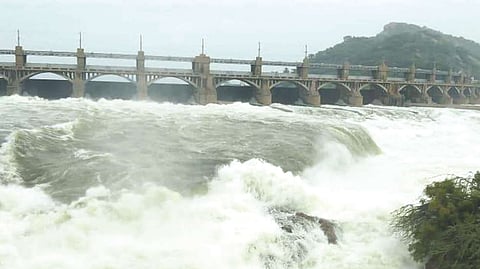

COIMBATORE: Every time when Cauvery swells, people in villages along the river course in Namakkal slip into agony. It has become a routine for water to enter into hundreds of houses in Komarapalayam and Pallipalayam areas.
As many as 439 families comprising 1,100 people, who were displaced by floods in Cauvery, have just returned to their houses from relief camps. With south west monsoon, which gives copious rains in the Cauvery catchment areas likely to be active till this month end, a cloud of uncertainty still hangs over their continued stay in their houses.
“Life has become a struggle due to long days of flooding in Cauvery, this monsoon season. Most of us have lost our valuables, electronic items and study materials of children after our houses got inundated,” said S Arumugam from Indira Nagar in Komarapalayam.
What they now look for is a permanent solution to the issue of flooding. “After flooding in 2018, this is nearly the third time that such an issue has happened. To provide a permanent solution, the Tamil Nadu Urban Habitat Development Board has come up with a proposal to build tenements to accommodate the people staying along Cauvery River banks. The district administration has identified 520 families to be living along the river bank. They will be accommodated in 520 houses to be built as tenements, works for which will commence soon,” said Namakkal Collector Shreya P Singh.
Generally, it’s the south west monsoon which causes heavy flooding in Cauvery due to copious rains in the catchment areas rather than the north east Monsoon, which brings widespread rains to Tamil Nadu. In fact, this SW monsoon has created a record of sorts too.
In the history of Stanley Reservoir in Mettur, this is the first time; the dam has discharged 360 TMC of water from June 1 till Friday (September 2), which is the maximum since its inception in 1934 resulting in heavy flooding in downstream Cauvery basin districts.
Earlier, the record discharge was in 1961, when 329 TMC was let out, while recording a highest inflow of 360 TMC. Currently, the dam has received 350 TMC so far since June 1. At this point of time, last year, the dam received an inflow of just 250 TMC and recorded a discharge of 240 TMC.
“The dam itself is depending on south west monsoon rains in Karnataka. Therefore, the inflow into the dam normally comes down during the north east monsoon season. And therefore, there will be no issues of heavy flooding during next monsoon as seen now,” said an official adding that maintenance works of the dam have been carried out routinely in good measure even if the dam is in its full reservoir level to ensure its stability.
“Meanwhile, since the onset of SW Monsoon in June 1, out of 38 districts only Kanniyakumari has recorded deficit rains of 238.2 mm as against a 30 years mean average of 373.8 mm, which is a minus 36 per cent,” said Dr SP Ramanathan, head of the Agro Climate Research Centre of Tamil Nadu Agricultural University (TNAU).
Districts such as Chengalpattu, Chennai, Kallakurichi, Kancheepuram, Tenkasi and Villupuram have received normal rains. The Nilgiris has so far received a maximum of 1,705.9 mm.
“The onset of north east monsoon depends on the retrieval of SW Monsoon,” Ramanathan added. Therefore, with the south west monsoon continuing to be still active, the administrations of Western districts are likely to roll out their plan of preparedness soon for the north east monsoon, which normally sets in around October.
Visit news.dtnext.in to explore our interactive epaper!
Download the DT Next app for more exciting features!
Click here for iOS
Click here for Android